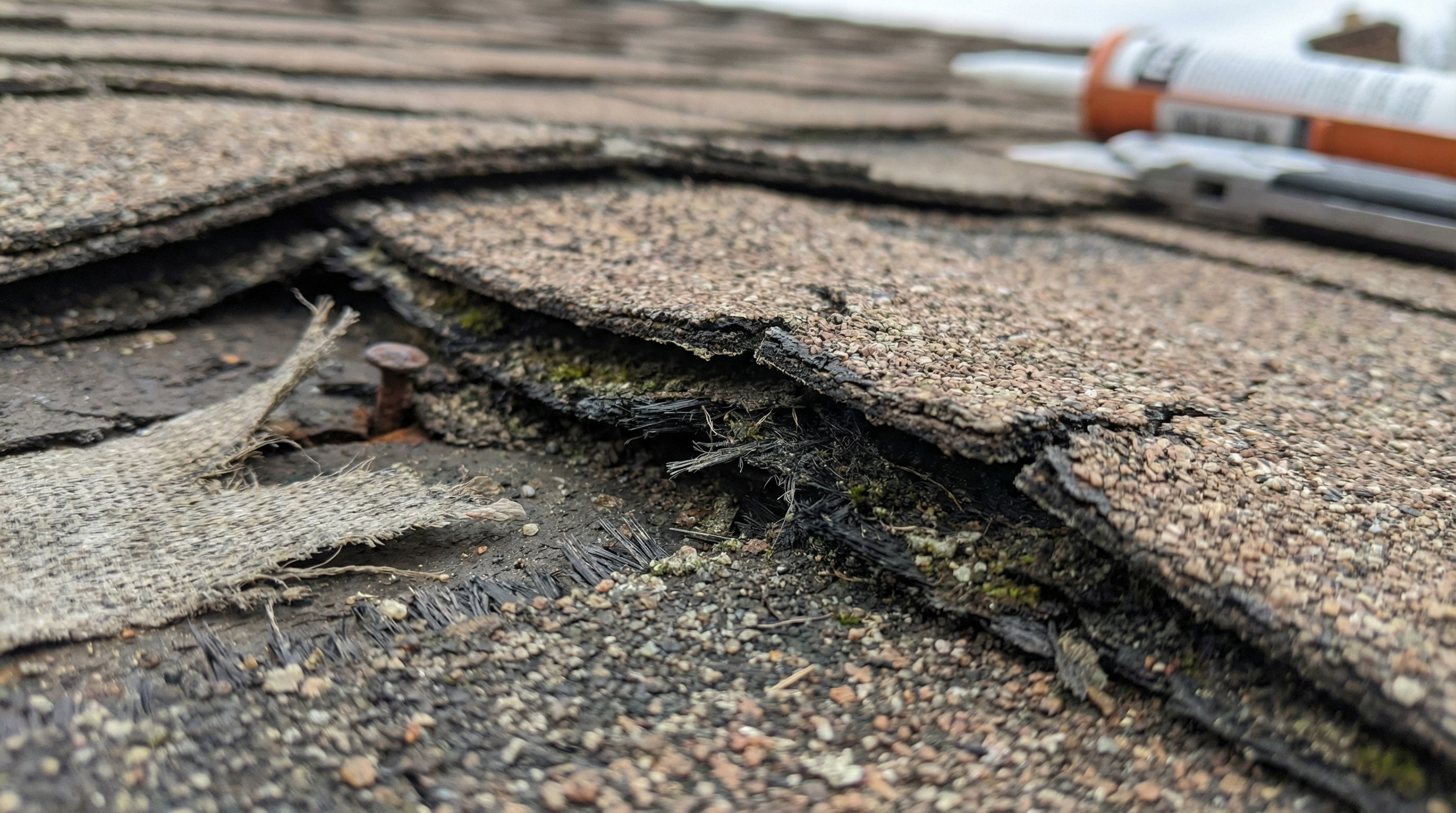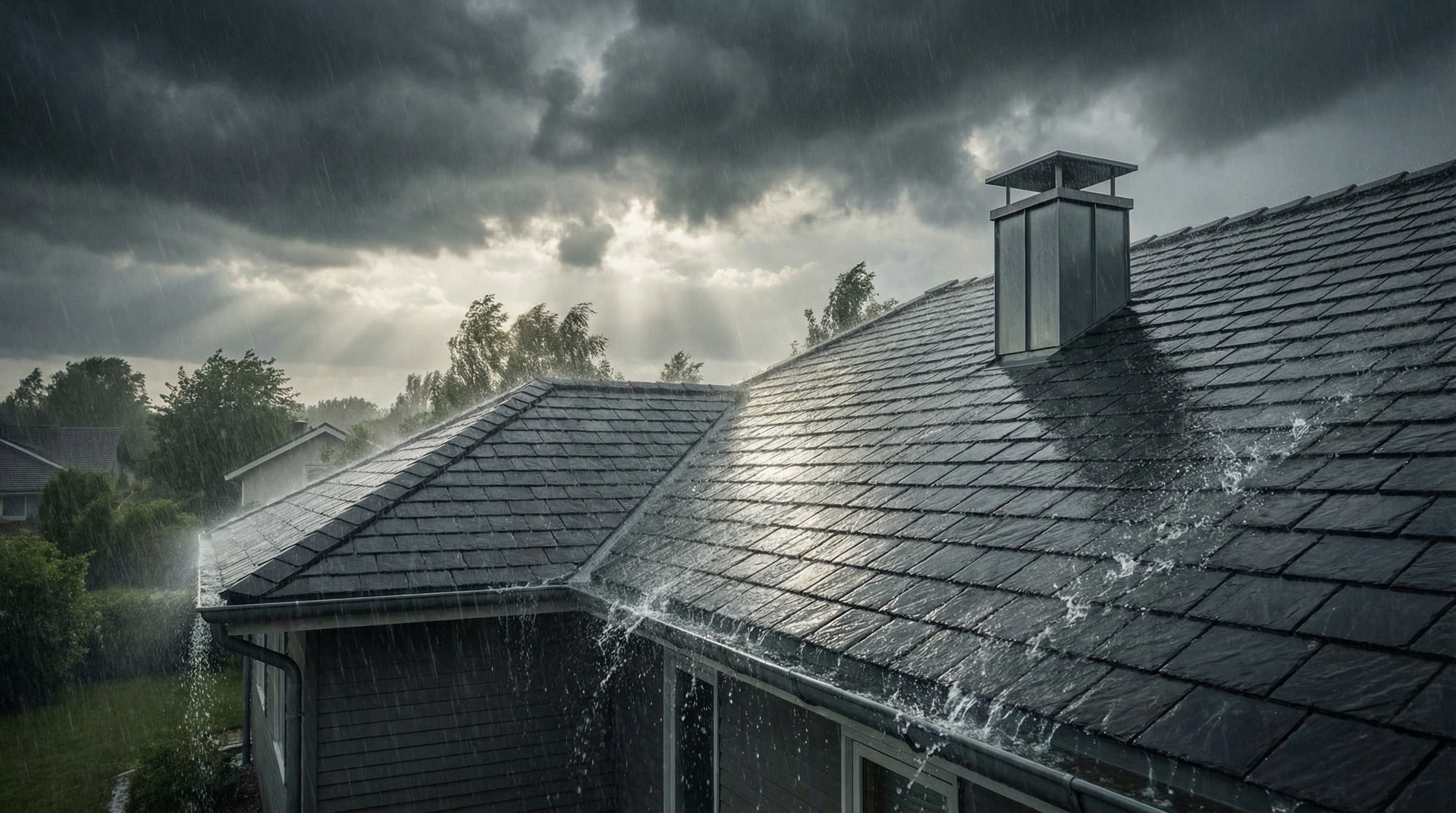Your roof isn't going to last forever, but determining exactly when it will need replacement can feel like guesswork. The truth is, replacement timing depends on a handful of factors that are easy to understand once you know what to look for.
This guide covers how long different roofing materials actually last, the warning signs that signal replacement is coming, and what you can do to stretch your roof's lifespan as far as possible.
How Often Should a Roof Be Replaced
Most roofs last somewhere between 15 and 50 years before replacement becomes necessary. The range is wide because the answer depends almost entirely on what your roof is made of, how well it was installed, and what kind of weather it has faced.
Asphalt shingle roofs, which cover the majority of homes, typically last 15 to 30 years. Metal roofs can go 40 to 70 years. Premium materials like slate or clay tile often reach 50 to 100 years when properly maintained.
However, there's an important caveat. Age alone doesn't determine when a roof fails. A 20-year-old roof that's been well-maintained in a mild climate might have years left, while a 10-year-old roof that survived multiple hailstorms and was poorly installed could already need replacement. The numbers below are guidelines, not guarantees—your roof's actual condition matters more than the date it was installed.
How long different roofing materials last
Your roofing material is the single biggest factor in how long you can expect your roof to last. Here's a quick reference:
Roofing Material | Typical Lifespan |
|---|---|
3-tab asphalt shingles | 15-20 years |
Architectural shingles | 25-30 years |
Wood shakes | 20-40 years |
Metal roofs | 40-70 years |
Flat roofs (TPO, EPDM) | 15-25 years |
Clay and concrete tile | 50-100 years |
Slate | 75-100+ years |
Here's what you need to know about each material.
Asphalt shingle roofs
Asphalt shingles are by far the most common roofing material in the U.S. They're affordable, widely available, and relatively straightforward to install.
Basic 3-tab shingles sit at the shorter end of the lifespan range. In moderate climates, you might get 15 to 20 years from them. In areas with intense sun, frequent storms, or temperature swings, that number can drop.
Architectural and dimensional shingles
Architectural shingles are a step up from basic 3-tab. They're thicker, with multiple layers laminated together, which creates a more textured appearance and better durability.
You can generally expect 25 to 30 years from architectural shingles. The extra thickness helps them resist wind and impact better than their thinner counterparts, which is why they've become the go-to choice for homeowners who want something between budget and premium.

Metal roofs
metal roofing sits at the longer end of the lifespan spectrum. Steel and aluminum versions commonly last 40 to 70 years. Copper can last even longer.
The main consideration with metal roofs is the higher upfront cost compared to asphalt shingles. But when you spread that cost over decades without replacement, the math often works in metal's favor. Metal also handles severe weather well, which is worth considering if you live in a storm-prone area.
Wood shake roofs
Wood shakes, typically made from cedar, offer a distinctive natural look. With consistent maintenance, they can last 20 to 40 years.
Consistent maintenance is crucial—wood is vulnerable to moisture, insects, and rot. Cedar shakes need periodic cleaning, treatments to prevent mold and mildew, and prompt replacement of any damaged pieces. In humid climates like parts of Tennessee, wood roofs require more attention than they would in drier regions. Neglect a wood roof, and you might get 15 years. Maintain it well, and 40 years is realistic.
Slate and tile roofs
Slate and clay tile represent the top tier of roofing longevity. Both materials routinely last 50 to 100 years, and slate can exceed that.
Keep in mind that slate and tile are much heavier than other materials. Your home's framing must be engineered to support the extra weight, which means these options aren't suitable for every structure. Installation also requires specialized skills—not every roofer works with slate or tile. Repairs can be expensive when they're needed, and walking on these roofs risks cracking individual pieces. But for homes built to handle them, these materials offer unmatched durability.
Flat roofs
Flat roofs use different materials than sloped roofs. Common options include TPO (a type of plastic membrane), EPDM (synthetic rubber), and built-up roofing (layers of tar and gravel).
Flat roofs typically last 15 to 25 years. They're common on certain home styles, additions, and commercial buildings. Drainage is the main concern with flat roofs since water doesn't run off as easily, so maintenance looks a bit different.
Signs you need to replace your roof
Age gives you a general timeline, but the condition of your roof tells you what's actually happening. Here are the warning signs that suggest replacement is on the horizon.
Curling, cracked, or missing shingles
When shingles start curling at the edges or cupping in the middle, they've lost their ability to keep water out. Cracked shingles create direct pathways for moisture. Missing shingles leave the wood underneath completely exposed.
A handful of damaged shingles in one spot can sometimes be repaired. When damage appears across multiple areas of your roof, replacement is usually the better option.

Sagging or soft spots in the roof deck
The roof deck is the layer of plywood or boards underneath your shingles. It's the structural foundation of your roof. When you notice sagging from the outside or feel soft spots when walking on the roof, moisture has likely been causing damage for a while.
Sagging is serious. It signals structural problems that will only get worse without intervention.
Leaks and interior water stains
Water stains on your ceiling or walls mean water is finding its way inside. If you have attic access, check up there after heavy rain. Look for damp insulation, water trails on rafters, or actual dripping.
Water stains on ceilings or walls usually mean the leak has caused more damage than you can see. By the time stains appear in your living space, moisture has typically been affecting the roof structure for weeks or months.
Granule loss in your gutters
Asphalt shingles are coated with small, sand-like particles called granules. Granules protect the shingle from UV rays and weather exposure.
Finding some granules in your gutters is normal, especially on newer roofs as loose particles wash away. On older roofs, heavy granule accumulation means the shingles are breaking down. Without that protective layer, deterioration accelerates.
Moss or algae growth
Moss holds moisture against your roof surface, which speeds up deterioration. A few small patches can be cleaned off. Widespread growth across large sections often indicates damage underneath.
Moss is especially common in shaded areas and humid climates. If you're seeing it everywhere, a closer inspection is worthwhile.
Damaged or failing flashing
Flashing refers to the metal strips that seal joints around chimneys, vents, skylights, and roof valleys. When flashing fails, water gets in even if the shingles themselves look fine.
Sometimes flashing can be repaired or replaced on its own. Other times, the water damage has already spread beyond the flashing area.
Visible daylight through the roof deck
This inspection method is straightforward. Go into your attic during the day and loo...
Visible daylight means replacement is likely coming soon.
What affects how often you need to replace your roof
Two identical roofs installed on the same day can have very different lifespans. Several factors explain why.
Local climate and weather patterns
Different weather conditions wear down roofs in different ways:
Intense sun: Causes shingles to dry out, crack, and lose granules faster
Heavy rain and humidity: Encourages moss, algae, and rot
Hail and wind: Creates immediate physical damage
Temperature swings: Causes materials to expand and contract repeatedly
In areas with harsh or variable weather, roofs tend to wear out faster than manufacturer estimates suggest.

Quality of the original installation
Poor installation dramatically shortens roof life. Shingles that aren't properly aligned, flashing that's incorrectly sealed, and inadequate ventilation all create problems that compound over time.
This is one reason why the contractor you choose matters so much. A well-installed roof can outlast a poorly installed one by years, even when using the same materials.
Attic ventilation and insulation
Proper ventilation allows air to flow through your attic, which prevents heat and moisture from building up. Without adequate airflow, shingles age faster from the underside.
Poor ventilation also contributes to ice dams in winter. Ice dams form when heat escapes through the roof, melts snow, and the water refreezes at the roof edge. That ice can force water back under the shingles.
Roof pitch and complexity
Roof pitch refers to how steep your roof is. Steeper roofs shed water and debris more effectively, which tends to extend their lifespan.
Complex roofs with multiple valleys, dormers, and penetrations have more potential leak points. More complexity generally means more places where things can go wrong.
How well the roof has been maintained
Regular maintenance extends roof life. Catching small problems early prevents them from turning into expensive replacements. A roof that's been inspected and maintained consistently will almost always outlast one that's been ignored.
How to make your roof last longer
A little attention over time can add years to your roof's life.
1. Schedule a professional inspection every year
Annual inspections catch small problems before they grow. A qualified inspector looks for damaged shingles, failing flashing, ventilation issues, and early signs of wear.
It's also smart to schedule an inspection after major storms, even if you don't see obvious damage from the ground.
2. Keep your gutters clean
Clogged gutters cause water to back up under your shingles. That standing water leads to rot and leaks that could have been avoided entirely.
Cleaning gutters in spring and fall handles most debris buildup.

3. Trim trees near your roofline
Overhanging branches scrape against shingles and drop leaves and twigs that trap moisture. During storms, falling limbs can cause serious damage.
Trees also create shade that encourages moss growth. Keeping branches trimmed back protects your roof in multiple ways.
4. Remove debris before it causes damage
Leaves, twigs, and other debris tend to collect in valleys and around chimneys. When debris sits on your roof, it traps moisture against the surface.
Clearing debris a few times a year prevents rot and extends your roof's useful life.
5. Fix small problems before they grow
Addressing small issues promptly can save significant money over time.
How to know if you actually need a new roof
Not every roof problem means full replacement. Here's a general framework:
Repair might be enough if:
Damage is limited to a small, localized area
Your roof is still relatively young
No structural issues are present
Replacement is likely needed if:
Damage is widespread across the roof
Your roof is approaching the end of its expected lifespan
Multiple warning signs are present at once
You see sagging or other structural problems
Since some contractors may recommend replacement when repair would suffice, getting multiple quotes from vetted professionals helps ensure you receive honest, unbiased recommendations.





